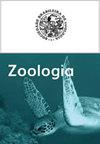Species composition and community structure of dung beetles (Coleoptera: Scarabaeidae: Scarabaeinae) compared among savanna and forest formations in the southwestern Brazilian Cerrado
IF 1.8
4区 生物学
Q4 ZOOLOGY
引用次数: 7
Abstract
Although dung beetles are important members of ecological communities and indicators of ecosystem quality, species diversity, and how it varies over space and habitat types, remains poorly understood in the Brazilian Cerrado. We compared dung beetle communities among plant formations in the Serra Azul State Park (SASP) in the state of Mato Grosso, Brazil. Sampling (by baited pitfall and flight-interception traps) was carried out in 2012 in the Park in four habitat types: two different savanna formations (typical and open) and two forest formations (seasonally deciduous and gallery). A total of 5,400 individuals collected comprised 57 species in 22 genera. Typical savanna had the greatest species richness and abundance, followed by open savanna and deciduous forest, while the gallery forest had the fewest species but high abundance. Tunnelers (one of three main nesting behavior guilds) showed the greatest richness and abundance (except in the gallery forest, where one dweller species was extremely abundant) in all plant formations. We found that species richness and abundance of the dung beetle community are influenced by differences among plant formations. Habitat heterogeneity in the different plant formations along with anthropic influences (fire, habitat fragmentation) are cited as important factors that explain guild and species richness and distribution patterns. These results emphasize the importance of protected areas, such as SASP, for the maintenance and conservation of species diversity in the Brazilian Cerrado.巴西塞拉多西南部稀树草原与森林地层中屎壳郎(鞘翅目:金龟甲科:金龟甲科)的种类组成与群落结构比较
尽管屎壳郎是生态群落的重要成员和生态系统质量的指标,但在巴西塞拉多地区,人们对屎壳郎的物种多样性及其在空间和栖息地类型上的变化知之甚少。我们比较了巴西马托格罗索州Serra Azul州立公园(SASP)植物地层中的蜣螂群落。2012年在该公园进行了四种生境类型的采样(采用诱捕陷阱和飞行拦截陷阱):两种不同的稀树草原类型(典型和开放)和两种森林类型(季节性落叶和廊道)。共采集到22属57种5400个个体。典型热带稀树草原的物种丰富度和丰度最高,其次是开阔热带稀树草原和落叶森林,廊道林的物种最少,但丰度较高。隧道蚁(三种主要筑巢行为行会之一)在所有植物形态中表现出最大的丰富度和丰度(除了走廊林,其中一种栖息物种非常丰富)。研究发现,不同植物形态对屎壳虫群落的物种丰富度和丰度有一定的影响。不同植物形态的生境异质性以及人为影响(火灾、生境破碎化)被认为是解释物种丰富度和分布格局的重要因素。这些结果强调了保护区(如SASP)对维持和保护巴西塞拉多地区物种多样性的重要性。
本文章由计算机程序翻译,如有差异,请以英文原文为准。
求助全文
约1分钟内获得全文
求助全文
来源期刊

Zoologia
生物-动物学
自引率
0.00%
发文量
15
期刊介绍:
Zoologia, the scientific journal of the Sociedade Brasileira de Zoologia (SBZ), is an international peer-reviewed, open-access Zoological journal that publishes original research on systematics, evolution, taxonomy, nomenclature, biogeography, morphology, physiology, biology, ecology, symbiosis, conservation, behavior, genetics and allied fields. The journal, formerly known as Revista Brasileira de Zoologia, publishes original articles authored by both members and non-members of the Society. The manuscripts should be written exclusively in English.
 求助内容:
求助内容: 应助结果提醒方式:
应助结果提醒方式:


